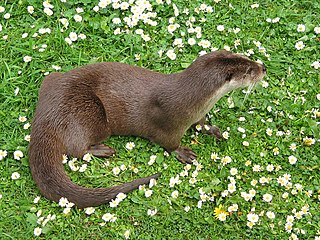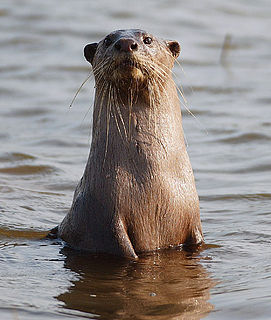
Otters are carnivorous mammals in the subfamily Lutrinae. The 13 extant otter species are all semiaquatic, aquatic, or marine, with diets based on fish and invertebrates. Lutrinae is a branch of the Mustelidae family, which also includes weasels, badgers, mink, and wolverines, among other animals.

The Sardinian pika is an extinct species of pika that was endemic to the islands of Sardinia, Corsica and neighbouring Mediterranean islands until its extinction likely in Roman times. Unlike living pikas, which all belong to the genus Ochotona, the Sardinian pika was the last surviving member of the genus Prolagus, a genus of pika once widespread throughout western Eurasia and North Africa during the Miocene and Pliocene epochs.

The Asian small-clawed otter, also known as the oriental small-clawed otter and the small-clawed otter, is an otter species native to South and Southeast Asia. It has short claws that do not extend beyond the pads of its webbed digits. With a total body length of 730 to 960 mm, it is the smallest otter species in the world.

The North American river otter, also known as the northern river otter and river otter, is a semiaquatic mammal that only lives on the North American continent, along its waterways and coasts. An adult North American river otter can weigh between 5.0 and 14 kg. The river otter is protected and insulated by a thick, water-repellent coat of fur.

The Eurasian otter, also known as the European otter, Eurasian river otter, common otter, and Old World otter, is a semiaquatic mammal native to Eurasia. The most widely distributed member of the otter subfamily (Lutrinae) of the weasel family (Mustelidae), it is found in the waterways and coasts of Europe, many parts of Asia, and parts of northern Africa. The Eurasian otter has a diet mainly of fish, and is strongly territorial. It is endangered in some parts of its range, but is recovering in others.

Lutra is a genus of otters, one of seven in the subfamily Lutrinae.

Aquila is the genus of true eagles. The genus name is Latin for "eagle", possibly derived from aquilus, "dark in colour". It is often united with the buteos, sea eagles, and other more heavyset Accipitridae, but more recently they appear to be less distinct from the more slender accipitrine hawks than previously believed. Eagles are not a natural group, but denote essentially any bird of prey large enough to hunt sizeable vertebrate prey.

The hairy-nosed otter is a semiaquatic mammal endemic to Southeast Asia and one of the rarest and least known otter species. It is threatened by loss of natural resources and poaching.

Athene is a genus of owls, containing nine living species, depending on classification. These birds are small, with brown and white speckles, yellow eyes, and white eyebrows. This genus is found on all continents except for Australia, Antarctica, and Subsaharan Africa. An evolutionary radiation of 4 species is also present in the Solomon Islands.

Lutrogale was proposed as generic name by John Edward Gray in 1865 for otters with a convex forehead and nose, using the smooth-coated otter L. perspicillata as type species.
Cyrnaonyx is an extinct genus of Lutrinae, otters from the Pleistocene. It was originally described by Helbing based on materials from France and he also attributed material from Corsica to it. The latter appeared to belong to another species and genus, Algarolutra majori. The only species of Cyrnaonyx is C. antiqua. It is known from the Pleistocene of Europe: France, Germany, Netherlands, Southern England and probably Italy.

Megalenhydris barbaricina is a Late Pleistocene giant otter from Sardinia. It is known from a single skeleton, discovered in the Grotta di Ispinigoli near Dorgali, and was described in 1987. The species is one of four extinct otter species from Sardinia and Corsica. The others are Algarolutra majori, Lutra castiglionis and Sardolutra ichnusae. This otter was large, possibly even larger than the extant Pteronura, which can reach two meters in length. The structure of the teeth points to a diet of shellfish and/or crustaceans. A special characteristic of the species is the flattening of the first few caudal vertebrae. This might point to a slightly flattened tail.

Sardolutra ichnusae is an extinct species of otter from the Late Pleistocene of Sardinia. It was originally described as Nesolutra ichnusae. It was a rather small species of otter, probably living in the sea. Among its characteristics is a relatively very large baculum, larger than in any living otter. The species probably evolved from a species of Lutra, maybe L. castiglionis.
Satherium is an extinct genus of otters that lived in North America during the Pliocene and Pleistocene. Two species are known, Satherium piscinarium and Satherium ingens.

Potamon ibericum is a Eurasian species of freshwater crab. It is an omnivore that feeds on land, but returns regularly to the water, and can survive short periods of drought in burrows and under stones. Its natural range stretches from north-eastern Greece, around both sides of the Black Sea and to beyond the Caspian Sea; populations have also been introduced to southern France. It is included as a near threatened species on the IUCN Red List, and is included in the Red Data Book for Ukraine. It belongs to the genus Potamon.
Algarolutra is an extinct endemic genus of otter from the Pleistocene of Corsica and Sardinia. The single species A. majori was originally attributed to the genus Cyrnaonyx and its type species C. antiqua, which was based on fossils from Corsica and also from mainland France. From mainland Europe, only lower dentition was known, whereas from Corsica and Sardinia only upper dentition was known. When a Cyrnaonyx antiqua fossil with both upper and lower dentition was found in England, it became clear that the species majori was too different to keep even in the same genus and the genus Algarolutra was described. appearing to belong to separate genera. A. majori is known only from very sparse evidence.

Rhagamys is an extinct genus of rodents in the subfamily Murinae, the Old World mice and rats. The genus was established by the Swiss zoologist Charles Immanuel Forsyth Major to accommodate Rhagamys orthodon, commonly known as Hensel's field mouse or the Tyrrhenian field rat, which is the only species in the genus. It was endemic to the Mediterranean islands of Corsica and Sardinia, where it first appeared in the fossil record in the Late Pleistocene, and was relatively large in size, weighing up to 50 g. Its closest living relatives are of the genus Apodemus.
Lontra weiri is a fossil species in the carnivoran family Mustelidae from the Hagerman Fossil Beds of Idaho. It shared its habitat with Satherium piscinarium, a probable ancestor of the giant otter of South America. It is named in honor of musician Bob Weir, and is the oldest known member of its genus. Prior to its discovery, Lontra was thought to have evolved from Lutra licenti, which dates from the Pleistocene of East Asia.
The Cretan otter(Lutrogale cretensis) is an extinct otter that was endemic to Crete during the Pleistocene.

Enhydrictis is a genus of extinct mustelid, belonging to the subfamily Galictinae. The type species, and best known, is Enhydrictis galictoides from the Pleistocene of Sardinia and Corsica.













